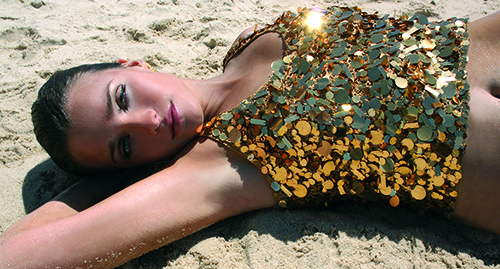HOW TO LOVE THE SUN
There is a lot of controversy about the sun: should we love it or avoid it. Here is the lowdown:

SUNSHINE, SUNSCREEN, HEALTH & BEAUTY
Freshly applied sunscreen absorbs UVA & UVB rays, reducing the number of free radicals formed in the skin. Re-applying frequently is important, as UV filters that have been in the sun for several hours tend to decompose and turn into free radicals themselves. You can protect yourself from this by reapplying regularly and always using sunscreen rich in antioxidants.
By blocking UV rays, sunscreen also prevents Vitamin D from being synthesised in your skin. Regular use of sunscreen and always covering up in the sun are linked to Vitamin D deficiency.
The most natutral way to boost your Vitamin D levels is to expose bare (moisturized, but sunscreen-free) skin to the sun. Vitamin D is a super-important Vitamin that influences nearly 3,000 genes, powerfully supports hormonal function, boosts your immunity and literally halves your risk of catching a cold. According to a study on over 10,000 individuals, correcting a Vitamin D deficiency can cut your risk of dying in half.
Allowing your children to play in the sun without sunscreen (with, temperature permitting, as much of their face, arms and legs exposed as possible) strengthens their teeth: Researchers found that children with severe caries had significantly lower vitamin D levels than cavity-free children. Vitamin D also strengthens your bones and protects from osteoporosis.
Even better, Vitamin D also protects from many forms of cancer: According to over 200 epidemiological studies, Vitamin D has a protective effect against pancreatic, lung, ovarian, breast, prostate and (believe it or not) skin cancer. Some researchers believe that up to 90% of breast cancers are due to Vitamin D deficiency, as healthy levels of Vitamin D have been shown to interfere with breast cancer cell’s ability to grow. Regular, moderate sun exposure has been shown in a global study to actually reduce your risk of melanoma, the deadliest form of skin cancer: Outdoor workers who are regularly in the sun have far fewer cases of melanoma than people who work indoors – so slathering on sunscreen which interferes with Vitamin D synthesis every time you are in the sun could inadvertently actually increase your melanoma risk.
Good levels of Vitamin D are crucial for pregnant women and their babies, lowering the risk of premature birth, low birth weight and C-section. Enough Vitamin D in a mother also boosts her baby’s immunity. Sadly, 80 percent of pregnant women worldwide have inadequate vitamin D levels.
So how do we optimize our Vitamin D levels?
Get some sun between 10am and 2pm when UVB rays are strongest: this is the best and safest time. During this time you need the shortest exposure time to produce Vitamin D because the (Vitamin D synthesising) UVB rays are most intense when the sun is high. When the sun goes down toward the horizon, UVB is filtered out much more than the dangerous UVA.
In terms of length of exposure, you only need enough sun to have your skin turn the lightest shade of pink. Once you reach this point your body will not produce any more Vitamin D in this sun ‘session’ and any additional sun exposure will simply cause harm and damage to your skin. The ideal time in the sun may therefore only be a few minutes if you have very pale skin. Such ‘therapeutic’ doses of sunshine also stimulate collagen synthesis & cellular renewal and can help heal skin conditions such as acne, eczema and psoriasis. The darker your skin, the more time in the sun you need to optimize your vitamin D production.
If you are terrified of wrinkles, feel free to protect your face with a wide brimmed hat and antioxidant moisturizer – but expose your body, in particular your tummy to the sun for a "therapeutic dose" every day if possible. Beneficial gut bacteria love sunshine and more Vitamin D is synthesized in the skin of our tummies than anywhere else in the body. You can reduce the risk of any sun damage to your skin by following the 'pink skin rule' drinking a daily BEAUTY SHOT, eating lots of antioxidant rich fruits and vegetables and making sure to keep up your natural Omega 3 & 6 levels - which help replenish skin sebum.
It takes up to 48 hours for the fat-based Vitamin D3 produced in your skin to be absorbed into your blood and actually raise serum Vitamin D levels. So make very, very sure to avoid washing your skin with soap for 48 hours after sun exposure if you want your actual Vitamin D levels to improve. It seems the world keeps itself too clean - Crazy but true.
According to specialists, your target Vitamin D3 serum level is 50-70 ng/ml.
In addition to raising our Vitamin D levels, regular sun exposure produces nitric oxide in our skin which makes our blood vessels more elastic, lowers high blood pressure and powerfully protects from heart attacks and strokes. Several independent studies show that regular, moderate sun exposure can slash your risk of a heart attack by a staggering 70%.
Natural sunshine also helps reduce pain, protects against depression and stimulates subcutaneous fat metabolism to help us stay slim.
Have a beautiful Summer !
_______________________
Sources :
(http://www.nbcnews.com/id/28796417/ns/health-skin_and_beauty/t/does-sunscreen-save-skin-or-damage-it/#.U-dQlFY8Bg3)
(http://articles.mercola.com/sites/articles/archive/2011/06/16/sun-can-protect-you-against-skin-cancer.aspx)
http://www.greenmedinfo.com
